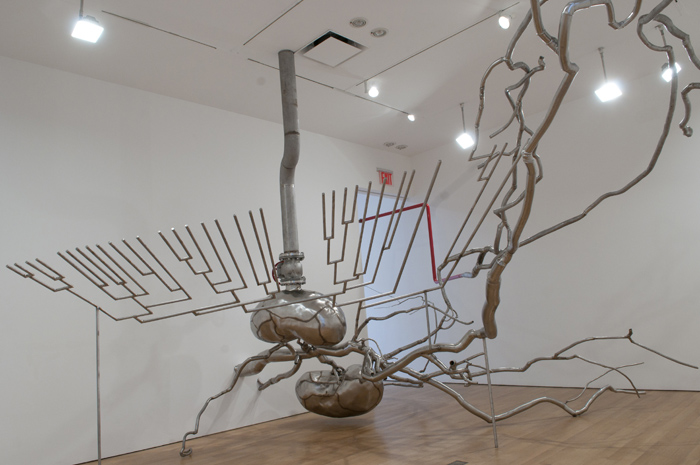Roxy Paine: It All Falls Apart

ROXY PAINE, DISTILLATION, 2010. PHOTO BY SHEILA GRIFFIN
COPYRIGHT THE ARTIST, COURTESY JAMES COHAN GALLERY
Roxy Paine’s current show, “Distillation,” at the James Cohan Gallery in New York is a continuous sculpture that winds through the interior of the gallery and insists you think about breaking down boundaries. Extending from the main entrance back into the administrative offices. This site-specific piece slightly echoes the artist’s Maelstrom (2009), his thorny treelike structure on the top of the Metropolitan, but takes on the form of blood vessels, with geometric interventions. As an abstract sculpture, with a small wall installation of handmade mushrooms that appear near the front desk, Distillation moves fluidly between figuration and abstraction in order to break down architectural barriers. We spoke what exactly he finds so compelling about the act of looking.
JILL CONNER: The description of your exhibition, “Distillation,” seems ironic, because this work is so much about movement, and so little about reduction. Could you elaborate?
ROXY PAINE: “Distillation” is really a conflagration and an overlapping of many different systems, a collision and an interweaving of elements. Simultaneously, I want to present these elements as a discrete moment. It’s seven kinds of systems represented in the piece; each one to me represents a framing of the world. Those seven are mycological (fungal), vascular, neural (study of brain and neuroscience), taxonomic (biological or way of classifying the natural world.)
CONNER: Is it suggesting the seventh is the kingdom of biology?
PAINE: No, there are no animals [in this schematic] actually. It’s just the seven fields that I find interesting. Each one is represented by a dendritic, branching structure that exists in nature. It also exists within our brains, but abstractly. It’s more like a a taxonomic diagram, where one branch splits into another.
ROXY PAINE, DISTILLATION, 2010. PHOTO BY SHEILA GRIFFIN
COPYRIGHT THE ARTIST, COURTESY JAMES COHAN GALLERY
CONNER: Like a template.
PAINE: Yes, and it’s probably no coincidence that there is this correlation between physical and mental structures. In the piece, there are pipelines that represent the industrial vision of the world. Then of course there are arborial, or tree forms, which represent botany. And then there are physical references to distillation, which represents chemistry. It’s very interesting, the origins of distillation, which was developed by alchemists who were very adept at breaking things down into parts. In fact, one of the tenets of alchemy, “solve a coagula,” means to separate and join together, or dissolve and join together.
CONNER: Do you think of these works as affecting a type of naturalism?
PAINE: Well I’ve always played back and forth: Being one thing or another is not of interest to me. I’m more interested in impurity and bouncing between elements freely.
CONNER: The way you’ve described it, there’s no narrative in this work, correct?
PAINE: That’s correct although I think potentially one could come up with their own narrative. But I would never want to have one single narrative that I create be the one that is then dictated. But if someone feels that narrative is suggested, I’m not opposed to that.
CONNER: It sounds like you’re a researcher, or an anthropologist, riffing off strategies used in the the world at large and putting them together into an installation format.
PAINE: I work outside of gallery settings quite a bit. I’m not tied to a four-walled interior, in terms of where the work can exist. But I think that the white cube has benefits in that it’s a place where you can really focus.
CONNER: What drew you to the environment, following the mass-produced sculptures that you made in 2000?
PAINE: Again, the machine-based works were occurring when I was going back and forth creating simulations of fungi and plant-based pieces, by which I mean to reflect a recurring theme of the past several hundred years. Simultaneously we’re breaking things down and isolating things, where every field becomes more and more specialized.
At the same time there is this tremendous hybridization, bringing everything closer together due to the Internet. So I think about things more on that level. Of course, environmentally, humans have the capacity to really mess up the world and we show ourselves more than willing to do that.
I guess rather than making a moral statement, I’m kind of examining the fact that we always want to mess with things in our environment, to alter nature and other things to their fundamental core. I don’t see that changing anytime soon, so it’s more like taking a step back and looking at that instinct, that tremendous tendency of humans.
CONNER: Are you referring to the destructive tendency?
PAINE: Well, we alter things and sometimes it’s not destructive. Sometimes the way we alter things can improve things. However, the potential for destruction is always there.
CONNER: Would a good analogy be the scientific cloning of livestock, plants and vegetables? A vain attempt to try to preserve the environment a certain way?
PAINE: Right. That’s an example of how we can’t stop altering and breaking things apart at their most fundamental level.






